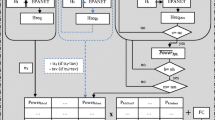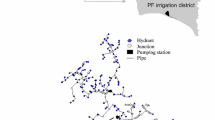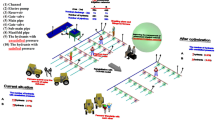Abstract
A tool named DOPIR (Dimensioning Of Pressurized IRrigation) was developed to optimize the process of water abstraction from an aquifer for pressurized irrigation systems. This tool integrates the main factors throughout the irrigation process, from the water source to the emitter. The objective is to minimize the total cost of water abstraction and application (C T) (investment (C a) + operation (C op) per unit of irrigated area according to the type of aquifer, crop water requirement and electricity rate periods. To highlight the usefulness of this tool, DOPIR has been applied to a corn crop in Spain with a permanent sprinkler irrigation system, considering two types of aquifer: confined and unconfined. The effects of parameters such as the static water table in the aquifer (SWT), irrigated area (S), number of subunits in the plot (NS), sprinkler and lateral pipe spacing, and average application rate (ARa) on C T have been analyzed. Results show that energy cost (C e) is the most important component of C T (50–72 % in the case studies). Thus, it is very important to adapt the design and management of the irrigation and pumping system throughout the irrigation season to the energy rate periods.








Similar content being viewed by others
Abbreviations
- A :
-
Investment annuity (€ T−1)
- ARa :
-
Average application rate of the irrigation system (L T−1)
- c :
-
Coefficient of the characteristic curve
- C :
-
Friction coefficient
- C a :
-
Investment annuity per unit of irrigated area (€ L−2 T−1)
- C as :
-
Investment annuity per unit of irrigated area, only in subunit (€ L−2 T−1)
- C e :
-
Energy annuity per unit of irrigated area (€ L−2 T−1)
- C es :
-
Energy annuity per unit of irrigated area, only to give the necessary pressure in subunit inlet (H su) (€ L−2 T−1)
- C i :
-
Total investment cost (€)
- C m :
-
Maintenance cost (€ L−2 T−1)
- C ms :
-
Maintenance cost, only in subunit (€ L−2 T−1)
- C op :
-
Annual operation cost (€ T−1)
- CRF:
-
Capital recovery factor
- C T :
-
Total annual cost of water application (€)
- C w :
-
Cost for transporting water from the source to the irrigation subunit inlet (€)
- dd:
-
Theoretical drawdown in the well (L)
- D :
-
Inner diameter of pipe (L)
- D d :
-
Drilling diameter (L)
- D l :
-
Diameter of lateral pipe (L)
- DL:
-
Dynamic water lift (L)
- D p :
-
Inner diameter of pumping pipe (L)
- D wp :
-
Inner diameter of well pipe (L)
- e :
-
Annual rate of escalation in energy costs (fraction)
- E a :
-
General application efficiency for the irrigation system (dimensional)
- E p :
-
Efficiency of pumping system (dimensional)
- EU:
-
Emission uniformity (dimensional)
- h :
-
The saturated depth of drilled aquifer after pumping (m)
- h a :
-
Average pressure head in the subunit (L)
- h f :
-
Pipe head loss with constant flow rate (L)
- h s :
-
Minor singular head losses (L)
- H :
-
Pressure head required at the pump
- H 0 :
-
Pressure head required at the inlet of the irrigation subunit (L)
- H s :
-
Saturated depth of aquifer before pumping (L)
- H su :
-
Pressure head required at inlet of the valve located in the origin of subunit (L)
- i :
-
Interest rate (fraction)
- L :
-
Pipe length (L)
- N :
-
Useful life (T)
- N p :
-
Power absorbed by the pump (kW)
- NS:
-
Number of subunits
- Ot:
-
Monthly operation time of the pump (T)
- Pa:
-
Power access price (€ kW−1 T−1)
- P :
-
Energy rate (€ kW−1T−1)
- P p :
-
Power of the pump (kW)
- P d :
-
Pump depth (L)
- P t :
-
Power of the transformer (kVA)
- q :
-
Specific capacity (L3 T−1 L−1)
- q a :
-
Average sprinkler flow in the subunit (L3 T−1)
- Q :
-
System flow from the aquifer (L3 T−1)
- Q o :
-
Inflow rate to the pipe (L3 T)
- Q 0s :
-
Inflow rate to the irrigation subunit (L3 T)
- R :
-
Radius of the cone of influence (L)
- R n :
-
Net crop irrigation water requirement (L3 L−2 T−1)
- R g :
-
Gross crop irrigation water requirement (L3 L−2 T−1)
- S :
-
Irrigated area (L−2)
- SWT:
-
Static water table (L)
- Ot:
-
Monthly operation time of the pump (T)
- T :
-
Transmissivity of the aquifer (L2 T−1)
- W d :
-
Well depth (L)
- WPD:
-
Impermeable depth in the top of confined aquifers (m)
- Δh :
-
Difference in extreme pressure heads in the irrigation subunit (% of h a)
- Δq :
-
Difference in extreme sprinkler flow in the irrigation subunit (% of q a)
References
Carrión F, Tarjuelo JM, Hernández D, Moreno MA (2013) Design of microirrigation subunit of minimum cost with proper operation. Irrig Sci 21:1199–1211
Carrión F, Montero J, Tarjuelo JM, Moreno MA (2014) Design of sprinkler irrigation subunit of minimum cost with proper operation. Application at corn crop in Spain. Water Resour Manag 28:5073–5089. doi:10.1007/s11269-014-0793-x
CHJ (Conferecaión Hidrgáfica del Jucar) (2014) http://www.chj.es/es-es/medioambiente/redescontrol/Paginas/Piezometr%C3%ADa.aspx. Accessed 10 Dec 2014
Custodio E, Llamas MR (1983) Hidrología subterránea. Omega, Barcelona
Daccache A, Ciurana JS, Rodriguez Diaz JA, Knox JW (2014) Water and energy footprint of irrigated agriculture in the Mediterranean region. Environ Res Lett 9:124014. doi:10.1088/1748-9326/9/12/124014
Fernández García I, Moreno MA, Rodríguez Díaz JA (2014) Optimum pumping station management for irrigation networks sectoring. Case of Bembezar MI (Spain). Agric Water Manag. doi:10.1016/j.agwat.2014.06.006
Hamm SY, Cheong JY, Jang S, Jung CY, Kim BS (2005) Relationship between transmissivity and specific capacity in the volcanic aquifers of Jeju Island, Korea. J Hydrol 310:111–121
Hassanli AM, Dandy GC (2000) Application of genetic algorithms for optimisation of drip irrigation systems. Iranian J Sci Technol Trans B 24(1):63–76
Kang Y, Yuan B, Nishiyama S (1999) Design of microirrigation laterals at minimum cost. Irrig Sci 18:125–133
Karmeli D, Keller J (1975) Trickle irrigation design. Rain Bird Sprinkler Manufacturing Corporation, Glendora, California
Keller J, Bliesner RD (1990) Sprinkler and trickle irrigation. Van Nostrand Reinhold, New York
Kumar D, Heatwole CD, Ross B, Taylor B (1992) Cost models for preliminary economic evaluation of sprinkler irrigation systems. J Irrig Drain Eng 118(5):757–775
Lamaddalena N, Fratino U, Daccache A (2007) On-farm sprinkler irrigation performance as affected by the distribution system. Biosyst Eng 96(1):99–109
Montero J, Tarjuelo JM, Carrión P (2001) SIRIAS: a simulation model for sprinkler irrigation. PART II. Calibration and validation of the model. Irrig Sci 20:85–98
Montero J, Martinez A, Valiente M, Moreno MA, Tarjuelo JM (2013) Analysis of water application costs with a centre pivot system for irrigation of crops in Spain. Irrig Sci 31(3):507–521
Moradi-Jalal M, Mariño MA, Afshar A (2003) Optimal design and operation of irrigation pumping stations. J Irrig Drain Eng 129(3):149–154
Moreno MA, Planells P, Córcoles JI, Tarjuelo JM, Carrión PA (2009) Development of a new methodology to obtain the characteristic pump curves that minimize the total cost at pumping stations. Biosyst Eng 102(1):95–105
Moreno MA, Córcoles JI, Moraleda DA, Martínez A, Tarjuelo JM (2010) Optimization of underground water pumping. J Irri Drain Eng 136(6):414–420
Nelder JA, Mead R (1965) A simplex method for function minimization. Comput J 7(4):308–313
Ortiz JN, Monteo J, Martinez R, Tarjuelo JM (2006) Set sprinkler irrigation and its cost. J Irri Drain Eng 132(5):445–452
Ortiz JN, de Juan JA, Tarjuelo JM (2010) Analysis of water application uniformity from a centre pivot and its effect on sugar beet (Beta vulgaris L.) yield. Biosyst Eng 105(3):367–379
Playán E, Salvador R, Faci JM, Zapata N, Martínez-Cob A, Sánchez I (2005) Day and night wind drift and evaporation losses in sprinkler solid-sets and moving laterals. Agric Water Manage 76:139–159
Pulido-Calvo I, Gutiérrez-Estrada JC, López-Luque R, Roldán J (2006) Regulating reservoirs in pressurized irrigation water supply systems. J Water Supply Res Technol 55(5):367–381
Sanz D, Gómez-Alday JJ, Castaño S, Moratalla A, De las Heras J, Martínez-Alfaro PE (2009) Hydrostratigraphic framework and hydrogeological behavior of the Mancha Oriental System (SE Spain). Hydrogeol J 17:1375–1391. doi:10.1007/s10040-009-0446-y
Scherer T, Weigel J (1993) In planning to irrigate. A checklistin. NDSU Extension Service. North Dakota State University. http://www.ext.nodak.edu/extpubs/ageng/-irrigate/ae91w.htm. Accessed 21 March 2003
Tarjuelo JM, Montero J, Carrión PA, Honrubia FT, Calvo MA (1999) Irrigation uniformity with medium size sprinklers. Part II. Influence of wind and other factors on water distribution. Trans ASAE 42(3):677–689
Tarjuelo JM, Ortega JF, Montero J, De Juan JA (2000) Modelling evaporation and drift losses in irrigation with medium size impact sprinklers under semi-arid conditions. Agric Water Manag 43:263–284
Van Der Gulik T (2003) Irrigation equipment cost. Ministry of Agricultural and Food, Abbotsford
Acknowledgments
The authors wish to express their gratitude to the Regional Ministry of Education, Culture and Sports of the JCCM, for funding the PEII-2014-011-P project and to the Spanish Ministry of Education and Science (MEC), for funding the AGL2011-30328-C02-01 and AGL2014-59747-C2-1-R projects (Co-funded by FEDER).
Author information
Authors and Affiliations
Corresponding author
Additional information
Communicated by S. Ortega-Farias.
Rights and permissions
About this article
Cite this article
Carrión, F., Sanchez-Vizcaino, J., Corcoles, J.I. et al. Optimization of groundwater abstraction system and distribution pipe in pressurized irrigation systems for minimum cost. Irrig Sci 34, 145–159 (2016). https://doi.org/10.1007/s00271-016-0489-5
Received:
Accepted:
Published:
Issue Date:
DOI: https://doi.org/10.1007/s00271-016-0489-5




